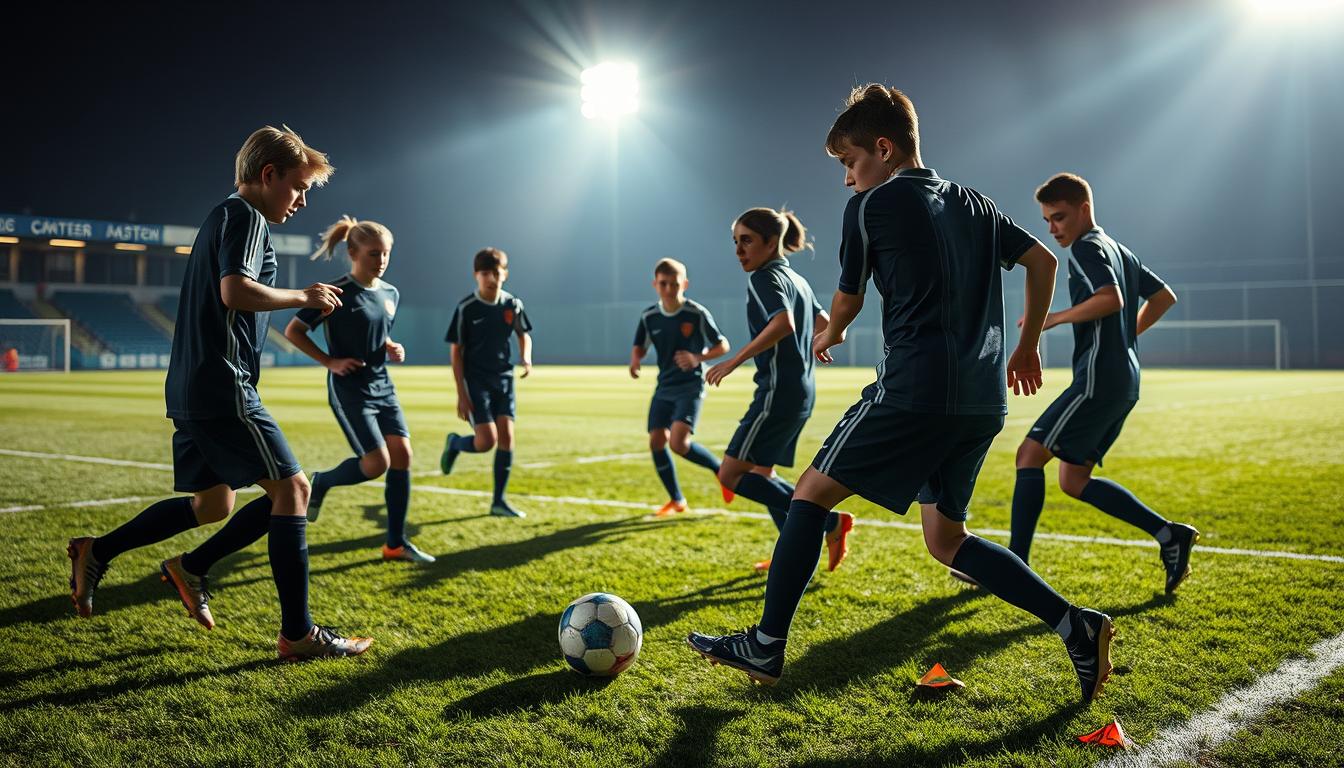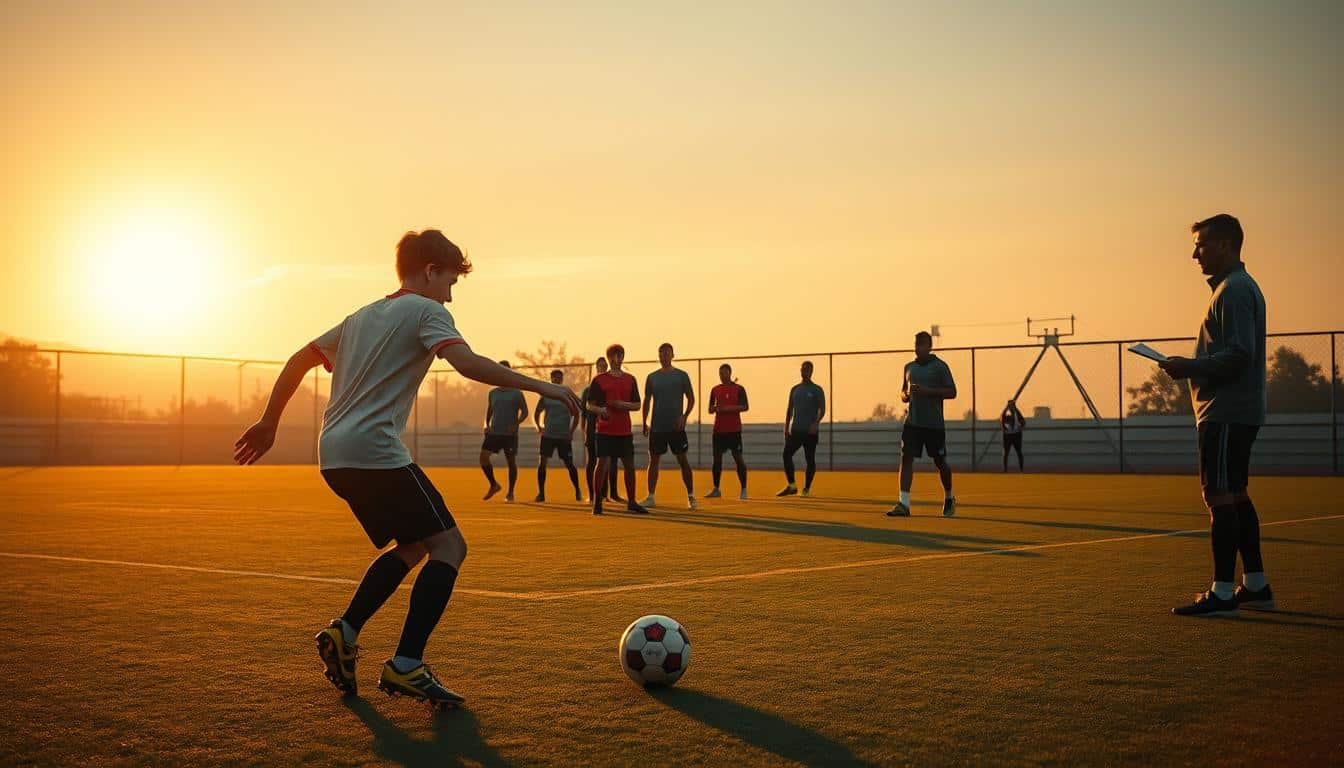Defender Training Plans for Kids

Mastering defensive skills starts with the right foundation. Whether you’re new to the game or aiming to sharpen your abilities, understanding positioning and awareness can transform how you protect your team’s goal. Modern football demands quick thinking and precise movements—qualities top academies like Alicante Football Academy prioritize in their youth programs.
Effective defense isn’t just about stopping opponents. It’s about reading the game, anticipating passes, and making smart decisions under pressure. By blending individual exercises with group activities, young players build confidence and coordination. For example, simple passing drills teach control, while tactical setups improve communication during matches.
Consistency matters. Regular practice helps kids develop muscle memory and adaptability. This guide breaks down proven strategies used by professionals, offering clear steps to elevate your game. Ready to become a stronger asset on the field? Let’s dive in.
Key Takeaways
- Strong defending relies on positioning, awareness, and quick decision-making.
- Professional academies use drills that combine individual and team-based exercises.
- Regular practice builds muscle memory and adaptability during games.
- Passing accuracy and communication are critical for defensive success.
- Tactical setups prepare players for real-game scenarios.
Understanding the Role of a Defender in Soccer
Great teams rely on players who can shut down attacks while sparking opportunities. Your job isn’t just to block shots—it’s to read the game, control space, and connect passes to teammates. Think of yourself as the team’s anchor, balancing protection and progression.
Key Defensive Skills
Success starts with mastering core abilities. Tackling requires timing—go in too early, and you’ll get beaten. Wait too long, and the opponent gains momentum. Tactical awareness lets you predict passes and intercept them. For example, top professionals like Virgil van Dijk excel at cutting off angles before strikers shoot.
| Skill | Purpose | Impact |
|---|---|---|
| Tackling | Disrupt attacks | Regain possession |
| Positioning | Control space | Reduce scoring threats |
| Passing | Build from the back | Start counterattacks |
Positioning and Awareness
Stay between the attacker and the goal. Adjust your spot based on the ball’s location. If the opponent moves left, shift right to limit their options. During a session, practice scanning the field every 3 seconds—this habit helps you spot open players and react faster.
Good defenders also support the attack. A well-timed run or pass can turn defense into offense. Teams like Liverpool thrive when full-backs overlap with wingers, creating sudden chances. Your role evolves with every play, blending safety and creativity.
Essential Drills to Boost Defensive Skills
Building a strong defense starts with practice that feels like play. These activities sharpen reactions while teaching how to outsmart opponents. Let’s explore two foundational drills that build confidence and technical mastery.
1v1 Defending Drills
Set up two cones 10 yards apart with a small goal. One player attacks while another defends. Focus on:
- Keeping your body sideways to limit shooting angles
- Quick footwork to mirror the attacker’s moves
- Timing tackles when they hesitate
Rotate roles every 3 minutes. This exercise teaches spatial control and improves passing under pressure.
Aerial Challenges and Heading Drills
Use a soft ball for safety. Have a partner toss it high while you jump to redirect it toward a target zone. Key tips:
- Keep eyes open and neck muscles firm
- Use your forehead for accurate contact
- Land balanced to recover quickly
Practice in groups of three to simulate crowded game moments. Maintain intensity by limiting each round to 90 seconds.
| Drill | Focus | Benefit |
|---|---|---|
| 1v1 Battles | Body positioning | Improves reaction speed |
| Aerial Duels | Timing jumps | Builds vertical strength |
| Passing Lanes | Interception skills | Enhances game reading |
Mix these drills weekly to see progress. Pair them with group scrimmages where players apply skills in live scenarios. Remember: quality repetitions beat half-hearted efforts every time!
Soccer defender training plans
To excel in defense, young players need a roadmap that blends skill drills with real-game tactics. Successful academies structure their programs around three pillars: physical readiness, tactical awareness, and technical precision. Each session balances individual growth with team coordination, ensuring players adapt to dynamic game situations.

- Agility drills to boost speed when closing gaps
- Positioning exercises to control high-risk areas
- Ball-centered scenarios like intercepting crosses or clearing headers
Individual sessions focus on refining footwork and reaction time. Team practices simulate pressure situations, teaching how to communicate and shift positions as a unit. For example, defenders might practice holding their line during a 3v2 counterattack drill.
Speed matters most when tracking back. Use short sprints paired with directional changes to mimic real-game recoveries. Always stay angled to force attackers toward less dangerous areas.
| Session Type | Focus | Outcome |
|---|---|---|
| Focused Drills | Technique repetition | Sharpen first-touch control |
| Game Simulations | Decision-making under stress | Improve spatial awareness |
Balls are used creatively—juggling builds coordination, while angled passes teach interception timing. Structured sessions ensure every minute builds toward game-day confidence. Stick to the plan, and watch your defensive instincts soar!
Combining Team Drills and Individual Exercises
Balancing teamwork and personal growth shapes standout players. Academies blend group challenges with focused skill work to create adaptable athletes. This mix helps you sharpen techniques while learning how to thrive in fast-paced matches.
Team-Based Game Situations
Group activities teach you to read the field as a unit. For example, 5v5 scrimmages force quick passes and coordinated positioning. You’ll learn when to press forward or cover for teammates—skills that build trust during real games.
Top colleges use small-sided games to simulate high-pressure moments. These drills highlight how communication and spacing prevent breakdowns. Working together builds chemistry, letting your team react instinctively under stress.
Individual Skill Enhancements
Personal practice targets weaknesses. Spend 10 minutes daily on heading drills to improve accuracy. Use a wall for solo passing exercises—aim for consistent, crisp touches with both feet.
For outside back roles, practice overlapping runs and quick crosses. Juggling boosts coordination, while cone dribbles refine close control. These sessions make you sharper in one-on-one battles during matches.
| Team Focus | Individual Focus | Outcome |
|---|---|---|
| Defensive shape drills | Targeted footwork | Confidence in all scenarios |
| Set-piece strategies | Reaction-time exercises | Faster decision-making |
Structured football training blends both approaches. Group work teaches tactics, while solo drills polish execution. Rotate between these methods weekly to see steady growth in your game.
How-To Guide for Engaging Defensive Practice
Creating fun, effective defensive practices requires smart planning. Focus on drills that feel like mini-games while teaching core skills. Let’s break down how to set up sessions that mirror real-game intensity while keeping players motivated.
Step-by-Step Drill Setup
- Mark Your Space
Use cones to create a 20×15-yard grid. Place two small goals (4 feet wide) at each end. This size forces quick decisions, just like in tight game situations. - Organize Equipment
You’ll need:- 6 cones
- 2 portable goals
- Soft practice balls
- Pinnies for team colors
- Run Pressure Scenarios
Start with 2v2 defending drills. Attackers try to score, while defenders work on closing gaps and intercepting passes. Rotate roles every 5 minutes to keep energy high.
For reaction drills, have players stand back-to-back. When you shout “go,” they sprint to win a loose ball. This sharpens reflexes and teaches explosive movements.
| Drill | Focus | Equipment |
|---|---|---|
| 1v1 Battles | Body positioning | Small goal, cones |
| Interception Lanes | Reading passes | 4 cones, 3 players |
| Recovery Sprints | Speed under pressure | Stopwatch, markers |
Always end with a play-back review. Ask players what worked and where they struggled. Adjust setups weekly to target growth areas while maintaining a lively, challenge-driven environment.
Advancing Positional Skills and Game Readiness
Growth on the field comes from pushing boundaries and embracing challenges. To excel beyond basic drills, players need scenarios that mirror real-match intensity. This builds the instincts required to thrive when every second counts.
Live Game Simulations
Small-sided matches (like 4v4) force quick decisions in tight spaces. For example, Ajax’s youth program uses these setups to teach defenders how to handle overlapping runs and sudden counterattacks. Key elements to emphasize:
- Communicate constantly to organize your backline
- Anticipate passes by watching attackers’ hips, not just the ball
- Recover quickly after intercepting a cross
These scenarios help bridge the gap between practice and matchday pressure. Players learn to adapt their positioning based on the flow of play.
Building Consistency and Focus
Repetition with purpose sharpens instincts. Dedicate 15 minutes daily to intercepting angled passes or clearing crosses under time limits. Here’s how to structure it:
| Practice Method | Focus Area | Outcome |
|---|---|---|
| Shadow Drills | Positioning | Spatial control |
| Timed Clearances | Decision speed | Confidence under pressure |
Top academies use video reviews to show players where to improve. Pair this with focused drills targeting weak spots. Consistency isn’t about perfection—it’s about incremental progress.
Stay alert, communicate clearly, and trust your instincts. When you want to improve, treat every drill like a championship moment. That’s how you become better at reading the game and owning your role.
Wrap-Up and Next Steps for Budding Defenders
Stepping up your game requires dedication and smart strategies. By focusing on positioning and working closely with a coach, you’ll build the instincts needed to shut down attacks. Remember: every drill sharpens your ability to read plays and react decisively.
Keep refining your touch through daily practice. Whether clearing crosses or intercepting passes, consistency turns effort into habit. Pair solo sessions with team activities to master both individual skills and group coordination.
Ready to level up? Join a local academy or club for structured feedback. These programs help you understand your part in the bigger picture—defenders aren’t just stoppers but organizers who spark counterattacks.
Progress takes time, but each session moves you forward. Stay curious, embrace challenges, and trust the process. With grit and guidance, you’ll transform into the reliable backbone every team needs.
